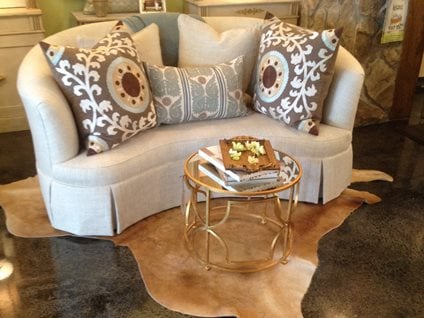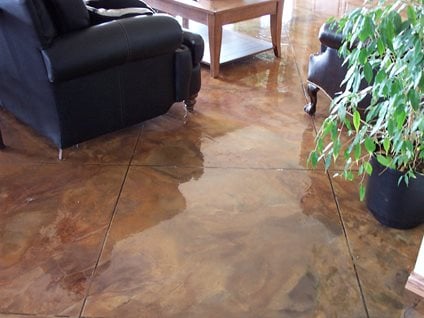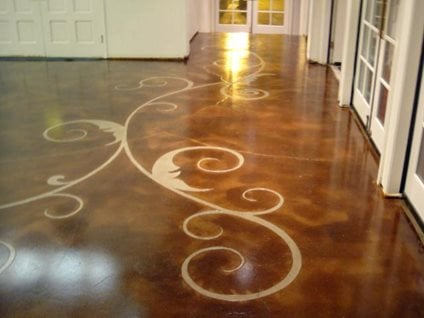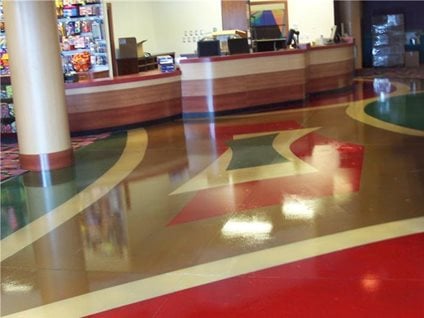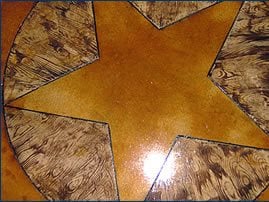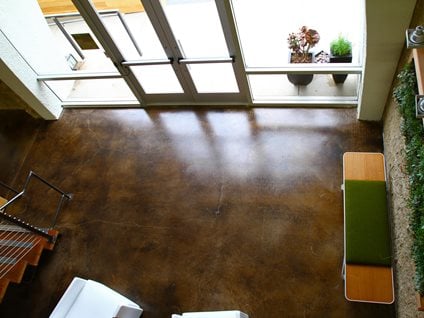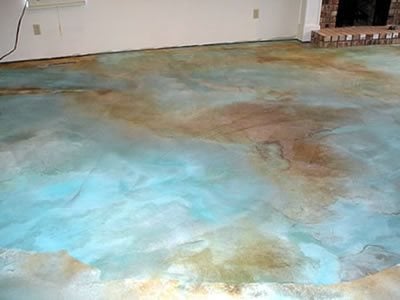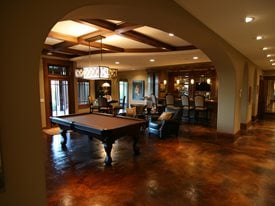
Game room floor gets upgrade with layers of rich stain. Concrete Arts, Hudson, WI
Staining is, by far, the most popular method for enhancing both commercial and residential concrete floors. Stains can be applied to both new or existing concrete floors and work equally well with concrete overlays.
Find concrete staining contractors near me.
STAINED CONCRETE FLOOR BENEFITS
Durability:
Because concrete stains penetrate deeply into the concrete surface, they produce fade-resistant, permanent color. Unlike with a paint or coating, the color won't flake off or peel away.
Design flexibility:
Concrete stains are highly versatile. You can achieve just about any look imaginable to suit your design tastes and budget. You can add subtle hints of color, bolder design accents, and even custom graphics. Sometimes the best approach is to keep it simple, with just one stain color that complements your decor; or be more daring and use multiple stain colors to create a custom look.
Eco-Friendly:
With more environmentally friendly options than ever before, stained cement floors are also an environmentally friendly option. Few flooring options offer the same longevity as concrete and will require replacement, which uses resources and creates disposal problems.
Stained Concrete Floors-Ideas for Concrete Stains
Time: 01:53
Watch an overview about RockMolds Lava Rock concrete stamp products.
FLOOR STAIN TYPES & COLORS
Depending on the look you want to achieve for your stained concrete floor, you can choose from acid-based chemical stains or water-based stains.
Acid-based stain:
Acid stains penetrate and react chemically with the concrete, creating natural color variations that add character and unique mottling effects, similar to the appearance of marble or granite. Acid stains are also good for use on floors designed to resemble wood. The color selection is generally limited to subtle earth tones, such as tans, browns, terra cottas, and soft blue-greens.
Water-based stain:
If you want to go beyond the subtle drama and subdued color palette of acid staining, consider using water-based stains, which come in a full spectrum of shades. In many cases, the different colors can be mixed, like water-based paints, to broaden your options.
Concrete floor stain colors:
Shades of brown and gray are the most popular stain colors for concrete floors, but don’t be afraid to try bolder shades, such as blue or black, to add more drama. See color charts of popular acid-and water-based stains.
RESIDENTIAL STAINED CONCRETE FLOORS
From farmhouse to modern, elegant to industrial, stained concrete floors can be designed to accompany just about any style of decor and used in any room in the house:
COMMERCIAL STAINED CONCRETE FLOORS
The combination of durability and customization options makes stained concrete the perfect choice for commercial flooring, and allow you to incorporate your company colors or logo right into the floor. Some of the places you may see stained cement floors are:
HOW TO STAIN CONCRETE FLOORS
The staining process takes about 2 days and should only be done on fully cured concrete (at least 3 to 4 weeks old). Staining is done in 4 basic steps:
- Clean and prepare the concrete.
- Apply the stain
- Clean and neutralize the stain
- Seal the surface to protect it long term
For more on the staining process, see How to Stain Concrete.
DIY: Can I stain concrete floors myself?
Although the steps may sound simple, it can be difficult to get it right—surface prep must be meticulous for even coloration and you must have good knowledge about the products you are using. And remember, stain is permanent, there's no going back if you make a mistake. Learn more about why we think staining is a job left for the pros.
